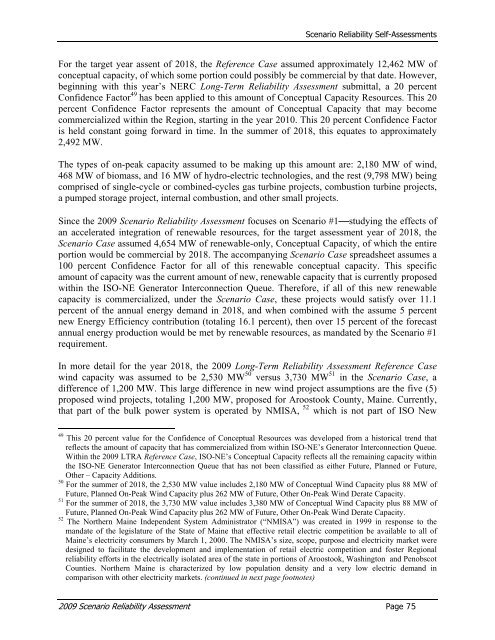2009 Scenario Reliability Assessment - NERC
2009 Scenario Reliability Assessment - NERC
2009 Scenario Reliability Assessment - NERC
- No tags were found...
Create successful ePaper yourself
Turn your PDF publications into a flip-book with our unique Google optimized e-Paper software.
<strong>Scenario</strong> <strong>Reliability</strong> Self-<strong>Assessment</strong>sFor the target year assent of 2018, the Reference Case assumed approximately 12,462 MW ofconceptual capacity, of which some portion could possibly be commercial by that date. However,beginning with this year’s <strong>NERC</strong> Long-Term <strong>Reliability</strong> <strong>Assessment</strong> submittal, a 20 percentConfidence Factor 49 has been applied to this amount of Conceptual Capacity Resources. This 20percent Confidence Factor represents the amount of Conceptual Capacity that may becomecommercialized within the Region, starting in the year 2010. This 20 percent Confidence Factoris held constant going forward in time. In the summer of 2018, this equates to approximately2,492 MW.The types of on-peak capacity assumed to be making up this amount are: 2,180 MW of wind,468 MW of biomass, and 16 MW of hydro-electric technologies, and the rest (9,798 MW) beingcomprised of single-cycle or combined-cycles gas turbine projects, combustion turbine projects,a pumped storage project, internal combustion, and other small projects.Since the <strong>2009</strong> <strong>Scenario</strong> <strong>Reliability</strong> <strong>Assessment</strong> focuses on <strong>Scenario</strong> #1—studying the effects ofan accelerated integration of renewable resources, for the target assessment year of 2018, the<strong>Scenario</strong> Case assumed 4,654 MW of renewable-only, Conceptual Capacity, of which the entireportion would be commercial by 2018. The accompanying <strong>Scenario</strong> Case spreadsheet assumes a100 percent Confidence Factor for all of this renewable conceptual capacity. This specificamount of capacity was the current amount of new, renewable capacity that is currently proposedwithin the ISO-NE Generator Interconnection Queue. Therefore, if all of this new renewablecapacity is commercialized, under the <strong>Scenario</strong> Case, these projects would satisfy over 11.1percent of the annual energy demand in 2018, and when combined with the assume 5 percentnew Energy Efficiency contribution (totaling 16.1 percent), then over 15 percent of the forecastannual energy production would be met by renewable resources, as mandated by the <strong>Scenario</strong> #1requirement.In more detail for the year 2018, the <strong>2009</strong> Long-Term <strong>Reliability</strong> <strong>Assessment</strong> Reference Casewind capacity was assumed to be 2,530 MW 50 versus 3,730 MW 51 in the <strong>Scenario</strong> Case, adifference of 1,200 MW. This large difference in new wind project assumptions are the five (5)proposed wind projects, totaling 1,200 MW, proposed for Aroostook County, Maine. Currently,that part of the bulk power system is operated by NMISA, 52 which is not part of ISO New49 This 20 percent value for the Confidence of Conceptual Resources was developed from a historical trend thatreflects the amount of capacity that has commercialized from within ISO-NE’s Generator Interconnection Queue.Within the <strong>2009</strong> LTRA Reference Case, ISO-NE’s Conceptual Capacity reflects all the remaining capacity withinthe ISO-NE Generator Interconnection Queue that has not been classified as either Future, Planned or Future,Other – Capacity Additions.50 For the summer of 2018, the 2,530 MW value includes 2,180 MW of Conceptual Wind Capacity plus 88 MW ofFuture, Planned On-Peak Wind Capacity plus 262 MW of Future, Other On-Peak Wind Derate Capacity.51 For the summer of 2018, the 3,730 MW value includes 3,380 MW of Conceptual Wind Capacity plus 88 MW ofFuture, Planned On-Peak Wind Capacity plus 262 MW of Future, Other On-Peak Wind Derate Capacity.52 The Northern Maine Independent System Administrator (“NMISA”) was created in 1999 in response to themandate of the legislature of the State of Maine that effective retail electric competition be available to all ofMaine’s electricity consumers by March 1, 2000. The NMISA’s size, scope, purpose and electricity market weredesigned to facilitate the development and implementation of retail electric competition and foster Regionalreliability efforts in the electrically isolated area of the state in portions of Aroostook, Washington and PenobscotCounties. Northern Maine is characterized by low population density and a very low electric demand incomparison with other electricity markets. (continued in next page footnotes)<strong>2009</strong> <strong>Scenario</strong> <strong>Reliability</strong> <strong>Assessment</strong> Page 75
















